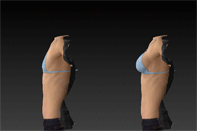Plastic Surgery Glossary
Confused about a certain plastic surgery term? You can find definitions for common aesthetic surgery and reconstructive surgery procedures here!
Aesthetic Surgery
Abdominoplasty – commonly called a “tummy tuck,” removes excess abdominal fat and skin with surgical tightening of abdominal muscles; gives the abdomen a flat and firm look and can narrow the waist.
Blepharoplasty – removes excess upper and/or lower eyelid skin and fat. Upper lid blepharoplasty is considered reconstructive if vision is impaired.
Breast augmentation – involves insertion of implants to increase breast size and give a woman fuller breasts; it can also correct minor breast sagging and breast asymmetry.
Breast lift – similar to breast reduction but involves removal of excess breast skin; the nipple is brought up to a normal position, changing breast shape but not size.
Brow lift – corrects changes caused by time including forehead lines, drooping eyebrows and upper lids, and frown lines. These facial characteristics make people appear tired and older than they really are.
Cheek implant – creates a better defined cheek line and gives the midface more definition. It involves surgically inserting an implant into the cheekbone area.
Chemical peel (chemosurgery) – restores wrinkled, scarred, or blemished facial skin by applying a chemical solution to peel away top layers of skin; old skin will be replaced during the healing process with a fresh, new skin surface.
Chin implant – a profile-enhancing procedure done in one of two ways: through an implant placed into the chin, or through chin bone surgery to reshape the bone itself. The result can be a stronger, firmer chin.
Dermabrasion – a sanding procedure used to remove wrinkles, acne or a scar. Skin irregularities are smoothed down, allowing the areas to blend in with the rest of the face.
Face lift – involves both the face and neck. Tissues in the face are tightened, including loose skin and muscles, and fat bulges in the neck are removed.
Hair restoration – using micro-grafts replenishes balding areas.
Laser resurfacing – C02 facial resurfacing rejuvenates sun damaged skin and treats fine wrinkles.
Lip augmentation – increases lip size and definition. In most cases, a patient’s own tissues, specifically fat or dermis and fat or dermal substitutes (i.e., Alloderm) are used.
Lip reduction – surgery to diminish size of the upper and lower lips.
Liposuction – involves the removal of isolated collections of fat from the thighs, abdomen, hips, arms, knees, calves, neck, and under the chin, using small incisions; generally used in areas that are not affected by dieting or exercise.
Otoplasty (ear) – sets back disproportionately large or prominent ears closer to the head; involves cutting cartilage and/or repositioning the ear inward. Plastic surgery can also help children who, because of a birth defect, need a new ear or to have one constructed.
Rhinoplasty (nose) – can be used to reduce a large nose, reshape the nose tip (often called tip plasty), remove a nasal hump, or improve the angle between the nose and upper lip. Rhinoplasty is also used to correct birth defects and problems associated with injuries to correct nasal airway obstruction.
RECONSTRUCTIVE SURGERY:
Breast reconstruction – a procedure or series of procedures done to rebuild a breast mound; provides breast support; a number of procedures are available:
-
Free microvascular tissue transfer (Free flap) – involves transferring tissue from the buttock area to reconstruct the breast.
-
Implant placement – an implant is placed under the chest muscle to create a breast-like fullness.
-
Skin/muscle flap (tummy flap and back flap) – skin and muscle are transferred from one area of the body to the chest and, when combined with an implant, help reconstruct the breast.
-
Nipple reconstruction – multiple techniques are available for nipple reconstruction. The most common technique utilizes adjacent skin to form the central portion of the nipple areolar complex. The outer areolar portion can be matched to the unaffected side employing tattoo techniques.
Breast reduction (Reduction Mammoplasty) – performed for medical reasons, such as back aches, shoulder problems, and breast crease irritation; involves reducing the breasts through the removal of excess skin and breast tissue.
Burn reconstruction – undertaken after recovery from an acute burn. Deformities resulting from an acute burn usually involve the hand, facial areas, and/or extremities. Burn reconstruction is usually a series of complex operative procedures to restore form and function to disfigured portions of the body.
Cleft lip – a birth defect that creates a unilateral or bilateral opening in the upper lip between the mouth and the nose. It causes disfigurement and makes feeding more difficult. Repair is performed to close the opening and create a normal lip and nose.
Cleft palate – a birth defect in which a lack of tissue development results in an opening in the roof of the mouth. The mouth and nasal cavity, normally separated by the palate, are open. Surgery to close the opening allows proper speech development, helps correct palate-related hearing problems, and allows for more normal dental growth and appearance.
Craniofacial reconstruction – a complex and delicate procedure or series of procedures that involve rebuilding the craniofacial (facial bones and tissue) skeleton or replacing tissue so that a normal anatomical appearance is achieved.
Hand surgery – performed on patients who have a congenital malformation, an injury, or degenerative disease that somehow affects the use of the hand. Common procedures are:
- Carpal tunnel syndrome – a numbness in the fingers caused by compression of a major nerve in the wrist. In surgery, the tissue compressing the nerve is removed, restoring normal function in the area.
- Dupuytren’s contracture – an abnormal finger position caused by scar formation in the palm or finger; unwanted tissue is removed, allowing the finger to move with more freedom.
- Rheumatoid arthritis – a severe joint deformity that restricts motion; tissue is removed and the joints are repositioned.
- Syndactyly – a congenital condition where two or more fingers are fused together; a zigzag incision separates the two fingers. Skin grafting may be necessary.
Laser surgery for vascular anomalies – the use of highly advanced laser technology to treat a number of abnormal blood vessel conditions. This includes port wine stains, facial spider veins, and hemangiomas. Procedures are quick, virtually painless, and very safe.
Microsurgery – the use of a microscope in the surgical process; very delicate, precise work involving the transfer of composite tissue from one area of the body to another to aid in the reconstruction of a deformity/defect.
Tissue expansion – used to reconstruct breasts, face, and extremities following birth defects, trauma, or tumor removal; involves the use of a special implant placed near the area where additional skin covering is needed. By gradually filling the expander with salt water over a period of several weeks, more skin is allowed to grow. The expander implant is removed and the new skin is used to cover the affected area.










